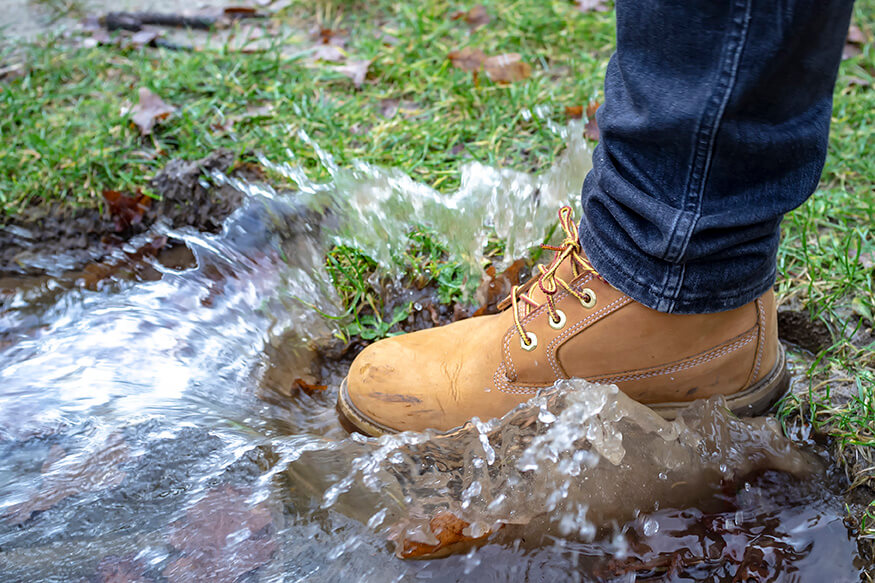Tips for Foot Health & Odour Control
As fall and winter bring colder, wetter weather, many of us face the daily struggle of keeping our shoes dry and comfortable. Wet shoes are not only inconvenient, but they can also have negative impacts on our foot health and lead to unpleasant odours. In this blog post, we’ll explore the problems wet shoes can cause, including the effect on foot health and odours, and provide you with effective tips on how to keep footwear dry in fall and winter, between uses.
The Negative Impacts of Wet Shoes
 Foot Health Concerns
Foot Health Concerns
Wearing wet shoes for prolonged periods can lead to several foot health issues. Prolonged exposure to moisture can soften the skin, making it more susceptible to blisters, fungal infections, and even frostbite in extremely cold conditions. Wet shoes may also cause the insoles to become waterlogged and lose their supportive properties, which can lead to discomfort and foot fatigue.
Unpleasant Odours
One of the most common complaints with wet shoes is the unpleasant odours they can produce. Moisture and warmth provide the perfect breeding ground for bacteria and fungi. When your feet sweat inside damp shoes, these microorganisms thrive and release foul-smelling by-products, resulting in that distinct and unpleasant foot odour.
Between Uses: How to Keep Footwear Dry in Fall and Winter
Choose the Right Footwear
Prevention is key when it comes to keeping your shoes dry. Choose footwear that is designed for wet conditions, such as high-quality waterproof boots or shoes made from materials like Gore-Tex. These options provide a reliable barrier against moisture and will help keep your feet dry even in wet weather.
Use Waterproofing Products
If you have non-waterproof shoes that you love, you can still make them more resilient to moisture by using waterproofing sprays or treatments. These products create a protective layer that repels water and helps keep your shoes dry.
Dry Your Shoes Properly
 If your shoes get wet, it’s essential to dry them properly to prevent foot health issues and odours. Remove any excess moisture by patting them with a dry cloth or paper towels. Do not place your shoes directly in front of a heater, as the direct heat can damage the materials. Instead, use a shoe dryer or stuff your shoes with newspaper to help absorb moisture and facilitate drying. And be sure to remove your orthotics, so that both they and the beds of your footwear can dry properly.
If your shoes get wet, it’s essential to dry them properly to prevent foot health issues and odours. Remove any excess moisture by patting them with a dry cloth or paper towels. Do not place your shoes directly in front of a heater, as the direct heat can damage the materials. Instead, use a shoe dryer or stuff your shoes with newspaper to help absorb moisture and facilitate drying. And be sure to remove your orthotics, so that both they and the beds of your footwear can dry properly.
Rotate Your Shoes
Rotating between multiple pairs of shoes is a great way to ensure they have time to dry out completely between uses. This not only prolongs the life of your shoes but also reduces the likelihood of odours developing.
Keep Your Feet Fresh
Wearing moisture-wicking socks can help keep your feet dry and reduce the amount of sweat that accumulates inside your shoes. You can also try our Foot Care Nurse’s recommendation of Podo Expert Shoe and Foot Deodorant Spray. It is a product designed to help with unpleasant foot odors and sweaty feet. On the natural side, it is enriched with tea tree oil and menthol.
Store Shoes Properly
When not in use, store your shoes in a cool, dry place. Shoe racks or well-ventilated shoe storage solutions will help prevent moisture buildup and promote air circulation, reducing the risk of odours and fungal growth.
Wet shoes in fall and winter can have negative impacts on both foot health and odours. However, by following the tips outlined in this blog post, you can keep your shoes dry and comfortable throughout the wet seasons. Remember that investing in proper footwear and taking care of your feet and shoes can go a long way in ensuring your feet stay healthy and odour-free. Don’t let wet shoes ruin your fall and winter; follow the steps above to keep your feet happy and dry!

